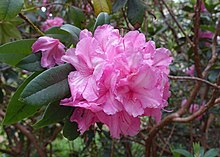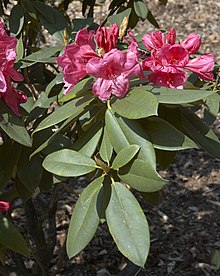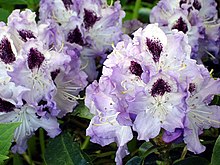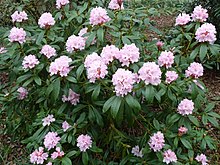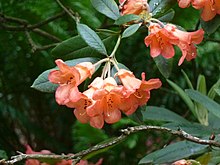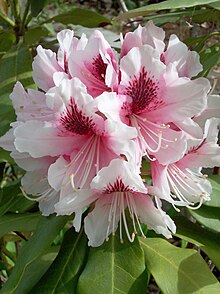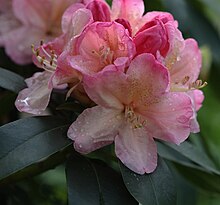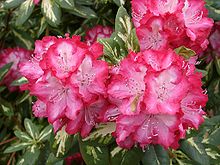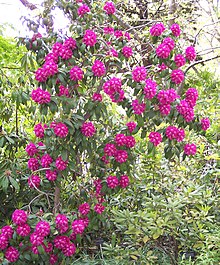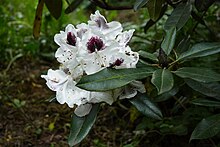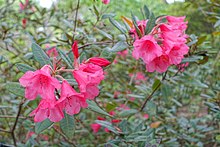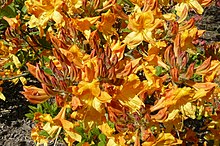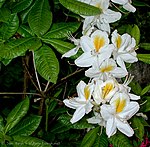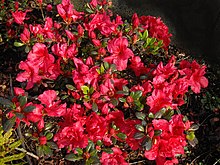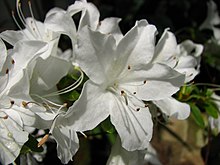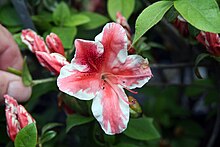Rhododendron varieties
The rhododendron varieties are the varieties or cultivars that have been bred from species of the genus rhododendrons ( rhododendrons ).
The varieties of rhododendrons can be divided into groups, with no strict systematic classification based only on external characteristics or only on botanical origin.
“Real” or “real” rhododendron hybrids
In breeding, rhododendron hybrids are usually grouped based on the names of the more important parent plants; Examples are the Griersonianum, Williamsianum and Yakushimanum hybrids, which have at least the growth habit and the leaf appearance of their parent species as more or less common characteristics, whereas they show great variability in the flower shapes. Rhododendrons are long-lived plants that usually continue to grow significantly with age, which is why size specifications are problematic. Roughly categorized, varieties up to 50 centimeters high are considered dwarfed, up to 1 meter high as small, 1 to 2.5 meters high as medium-sized, the rest as large. The flowering time of most forms is in the first six weeks after the onset of spring; this time is referred to below as the “mid-season” of the flowering period. Unless otherwise stated, the varieties in the following overview are hardy for Central Europe .
- 'Alice': This Griffithianum hybrid can grow large as a shrub and has six-inch leaves. The flowering time is in the middle of the season. The bright pink flowers are in large corymbs.
- 'Alison Johnstone': This variety grows as a medium-sized, bushy shrub with a narrow, upright habit. The leaves are round and blue-green. The flowering time is in the early middle of the season. The flowers, arranged in small clusters, are funnel-shaped and yellowish to pink in color.
- 'Anna': One of the two parent plants of 'Lem's Monarch' and 'Point Defiance'.
- 'Anna-Rose Whitney': This large shrub has medium green, oval leaves that are 6 to 8 inches long. The late-blooming variety bears 10 centimeter large, dark pink flowers in up to 12-fold corymbs.
- 'Annie E. Endtz': This descendant of the 'Pink Pearl' variety has been known since 1939. It grows as a medium-sized shrub. The leaves are broad with a waxy surface. The flowering time is shortly after the middle of the season. The pink flowers are ruffled and stand in round corymbs.
- 'Arthur J. Ivens': This Williamsianum hybrid has a small, compact, rounded habit. The leaves are small and oval. The flowering time is in the middle of the season or earlier. Bell-shaped flowers with a dark pink color stand in open corymbs.
- 'Babylon': This variety is medium-sized and has a dense, rounded habit. The narrow leaves are 10 to 15 centimeters long. The flowering time is early. In conical corymbs there are 9 to 15 pale pink funnel-shaped flowers with a brown throat.
- 'Betty': This variety grows as a large shrub with thick, medium-green leaves. The flowering time is in the middle of the season. There are dark pink flowers in cone-shaped corymbs.
- 'Bibiani': One of the parent plants of this hybrid is Rhododendron arboreum . It bears 10 to 15 centimeters long, dark green and veined leaves. The flowering time is early. In 11 to 15-fold corymbs there are 5 centimeters, dark red, bell-shaped flowers. The variety 'Gibraltar', which has similar flowers, is derived from this hybrid.
- 'Billy Budd': The small shrub has elliptical, slightly tomentose leaves. The flowering time is in the middle of the season. There are 10 to 12 waxy, bright red flowers in flat corymbs.
- 'Blue Boy': This variety grows as a medium-sized shrub and has narrow, dark green leaves 10 to 15 centimeters long. There are up to 20 violet-blue, dark-spotted, funnel-shaped flowers around 5 centimeters in size in dense, rounded corymbs.
- 'Blue Peter': This variety was bred in the English nursery Waterer in 1933 and is probably derived from Rhododentron ponticum . Their leaves are glossy dark green. The flowering time is in the middle of the season. The flowers, which stand in corymbs, are ruffled and lavender-blue in color with a noticeable black-red blotch.
- 'Brickdust': This Williamsianum hybrid grows as a small shrub with a compact, rounded habit. Their leaves are about two inches long. The flowering time is in the middle of the season. There are numerous dark orange, bell-shaped flowers in loose corymbs.
- 'Britannia': This medium-sized shrub is leafy with narrow, 10 to 15 centimeters long, sometimes slightly drooping leaves. The flowering time is in the middle of the season or a little later. The bright scarlet flowers are in large corymbs.
- 'Bruce Brechtbill': One of the starting plants is the 'Unique' variety. 'Bruce Brechtbill' grows like a medium-sized shrub. The leaves are relatively thick, elongated and dark green. The flowering time is in the middle of the season or earlier. The yellow-pink flowers are in cone-shaped corymbs.
- 'Cherry Custard': This variety has its origin in Canada and is descended from 'Fabia'. It is almost prostrate. The leaves are narrow, pointed and elliptical. The flower buds are orange-red. The yellow flowers are in flat 10 to 12-fold corymbs.
- 'Christmas Cheer': This Rhododendron caucasicum hybrid is leafy with elliptical, 5 to 10 centimeters long, medium green leaves. The flowers are white to light pink in color in 5- to 11-fold corymbs; the flower buds are darker. It is one of the earliest flowering varieties; their flowers are often destroyed by late frosts.
- 'Cinnkeys': This variety was bred in 1926 from the parent plants Rhododendron cinnabarinum and Rhododendron keysii . Its name is composed of the four first letters of the type epitheta of these two parent plants. The oval leaves are glossy medium green. The tubular flowers are conspicuously waxy, red and mostly yellow at the tip.
- 'Cornubia': This variety is derived from Rhododendron arboreum . It grows as a large shrub and is not completely hardy. The 15 centimeter long leaves are curled and medium green. The flowering time is early; the flowers are often victims of late frosts. The funnel-shaped, bright red flowers sit in 7 to 11 flowered umbels.
- 'Countess of Haddington': This variety, bred in 1862, is not entirely hardy. It grows as a medium-sized, well-formed shrub. The leaves are up to 10 centimeters long and are slightly shiny and bronze-green. In groups of three to five the large, bell-shaped flowers are whitish and often pink in color.
- 'Crest': This variety was bred in England in 1953. It grows as a medium-sized, somewhat loose shrub. It was one of the first varieties for which to obtain the breeding goal "to frost and yellow flowers" not Rhododendron burmanicum but Rhododendron wardii was used.
- 'Dido': This variety was bred in England in 1934. It served less as a garden plant and more as a basis for breeding other forms, including 'Lem's Cameo', a form that is important in American rhododendron breeding. 'Dido' grows as a shrub up to 1 m high and has round, light green leaves. The flowers, arranged in open corymbs, are trumpet-shaped, orange to pink in color and yellow in the center.
- 'Dora Amateis': It is one of the few hybrids that are descended from the species Rhododendron minus . The small shrub has elliptical, pointed leaves that are fragrant and initially bronze-colored, later dark green. The flowering time is at the beginning of spring. The funnel-shaped and white flowers are in clusters of three to six. When the shrub is in full bloom, the leaves are almost completely covered by the flowers.
- 'Eldorado': This variety is derived from the species Rhododendron johnstoneanum . It grows as a medium-sized shrub with a somewhat loose habit and is not completely hardy. The small leaves are scaly and dark olive green. The flowering time is early. The 5-centimeter, funnel-shaped flowers of bright yellow color are in clusters of two to three.
- 'Elisabeth Hobbie': This variety is derived from the species Rhododendron forrestii . The dark green leaves are round and up to 5 centimeters long. The leaf stalks and the annual new shoot are reddish. The flowering time is in the middle of the season. The bell-shaped, red flowers are five to seven in clusters.
- 'Elizabeth': This variety, derived from the species Rhododendron griersonianum , forms a medium-sized shrub with an open habit. The 8 to 10 centimeters long leaves are narrow and pointed. The flowering time is in the middle of the season. The almost 10 centimeters wide, funnel-shaped and bright red flowers are in 6-8-flowered corymbs.
- 'Empire Day': See 'Romany Chai'.
- 'Fabia': This cross between the species Rhododendron dichroanthum and Rhododendron griersonianum played an important role in the further breeding of new hardy varieties with yellow to orange flowers. It grows up to 1 m high and a little more in width. The up to 10 centimeters long leaves are elliptical and tapering to a point. The flowering time is in the middle of the season. The bell-shaped flowers are in open, 3- to 7-fold corymbs with a soft orange color.
- 'Fabia Tangerine': Is only mentioned briefly in 'Percy Wiseman', of which she is a parent plant.
- 'Fastuosum Flore Pleno': This variety grows as a large shrub and is not completely hardy. The flowering time is in the middle of the season or later. The 10 to 15 centimeter long leaves are medium green. The half-double flowers, dark lavender-colored with greenish-yellow markings, are in 7 to 15-fold corymbs,
- 'Fragrantissimum': This hybrid, created before 1868, is descended from the species Rhododendron edgeworthii . Their growth habit is somewhat loose. The pointed, 10 cm long leaves are green to bronze in color. The flowering time is in the middle of the season. The large, funnel-shaped, fragrant flowers are whitish to pink in color and are in open 3 to 7-fold corymbs. Because of its fragrant flowers, it is still a popular variety today.
- 'Frank Baum': This American hybrid, bred in 1969, is named after Frank L. Baum , author of the book The Wizard of Oz . The leaves are thick and dark green with reddish petioles. The flowering time is late. The flowers are yellow and coral red in the middle; they are in 10 to 14-fold umbellate clusters.
- 'Furnivall's Daughter': This variety grows as a sturdy, medium to large shrub. The leaves are large and shiny green. The flowering time is in the middle of the season or a little later. The flowers, whose color is bright pink with a dark spot, stand in long corymbs.
- 'George's Delight': It is one of the "modern" rhododendron hybrids. It grows as a small, dense shrub. The leaves are glossy medium green. The flowering time is in the middle of the season. The pale yellow to cream-colored flowers with a pink edge are in conspicuous, rounded corymbs.
- 'Gibraltar': See the description under 'Bibiani'.
- 'Golden Wit': This variety grows as a small, somewhat spreading shrub. The round leaves are glossy green and up to 5 centimeters long. The flowering time is in the middle of the season. The bell-shaped flowers are drawn in a delicate golden yellow and red to reddish brown. They stand together in clusters of up to 9.
- 'Good News': This variety grows as a medium-sized shrub. The leaves are light green when young; initially they are hairy on both sides, later only brown felted on the underside. The flowering time is in late spring. The flower buds are bright red. The funnel-shaped flowers are crimson and are in 12 to 15-fold corymbs.
- 'Grumpy': This variety, derived from the species Rhododendron yakushimanum , grows as a small to medium-sized shrub and has dark green leaves. The flowering time is in the middle of the season. The cream-colored to light yellow, mostly pink flowers are found in round corymbs.
- 'Halopeanum': This fast-growing, very robust, large shrub has dark green leaves. The flowering time is in the middle of the season. The pale pink flowers, which later fade, stand in long, cone-shaped corymbs.
- 'Honeymoon': This hybrid of the species Rhododendron wardii forms a medium-sized shrub with a rounded, dense growth habit. The thick leaves are dark green. The flowering time is in the middle of the season. The pale yellow, often slightly orange flowers are in flat, up to 15-flowered corymbs.
- 'Hotei': This variety plays an important role in the breeding of hardy yellow flowering varieties. It grows as a small to medium-sized shrub and has rounded leaves about 10 centimeters long. The flowering time is in the middle of the season. The bell-shaped, bright yellow flowers are in round, up to 12-fold corymbs.
- 'Hydon Dawn': Like 'Hydon Hunter', this variety also comes from the species Rhododendron yakushimanum , but is less well known. It grows as a small, rounded shrub with glossy, bright green leaves. The flowering time is in the middle of the season. The flowers are pink, slightly lighter on the edge; they stand in small, round cone clusters.
- 'Hydon Hunter': This variety is derived from the species Rhododendron yakushimanum .
- 'Impi': The medium-sized shrub has dark green leaves. The flowering time is in the middle of the season or later. The dark purple flowers are in small, round corymbs.
- 'Irene Stead': This variety bred in New Zealand is very similar to the related 'Loderi' hybrids. It grows as a large shrub with 20 centimeters long, medium green leaves. The flowering time is in the middle of the season. The slightly waxy, light pink or white flowers stand in large, cone-shaped corymbs.
- 'Jingle Bells': This hybrid is related to 'Fabia'. It grows as a graceful, small shrub with dense foliage. The narrow, about 10 centimeters long leaves are dark green. The flowering time is in the middle of the season. The flower buds are orange-red. The bell-shaped flowers stand in 5- to 9-fold corymbs; they are orange in color and later fade yellow.
- 'King George': See the entry 'Loderi'.
- 'Kubla Khan': This variety grows as a medium-sized shrub with bright green leaves. The flowering time is in the middle of the season. The flowers are conspicuous with large sepals that look like they have been pulled over. The flower color varies from red to pink and orange on a cream-colored background.
- 'Lemon Lodge': This hybrid, bred in New Zealand, is descended from the species Rhododendron wardii . It grows as a medium to large shrub. The oval and about 10 centimeters long leaves are waxy and bright light to medium green. The pastel yellow flowers are in relatively flat corymbs.
- 'Lem's Aurora': This variety grows as a small to medium-sized, compact shrub. The leaves are dark green and about 10 centimeters long. The flowering time is in the middle of the season. The crimson-red flowers with pale yellow in the center and sepals of the same color stand in corymbs .
- 'Lem's Cameo': This medium-sized shrub with a rounded habit has glossy, dark green leaves that are 10 centimeters long. The fresh new shoot is bronze colored. There are funnel-shaped flowers in up to 20-fold corymbs, the color of which is peach-pink, darker towards the edge and has a basal pink spot.
- 'Lem's Monarch': This variety is a cross between the varieties 'Anna' and 'Marinus Koster'. Since it has the same parents as the 'Point Defiance' variety, it shares many characteristics with them. It grows as a large shrub with dense foliage of rounded, glossy medium green leaves up to 20 centimeters long. The funnel-shaped flowers, which stand in 9 to 15-fold corymbs, are white to light pink in color with dark pink to crimson edges.
- 'Loderi': This is a collective name for a group of hybrids that were created around 1900 from crossing the species Rhododendron griffithianum and Rhododendron fortunei . They are tall, often tree-like, and have medium to bluish green leaves 15 to 20 centimeters long. The flowers are white to pink, depending on the variety, and are in large corymbs. This group includes the varieties 'King George' (white flowers that develop from pink buds), 'Sir Edmond' (very large, light pink flowers) and 'Sir Joseph Hooker' (light to medium pink flowers).
- 'Loder's White': This variety originated earlier than the varieties of the Loderi group to which it resembles. It grows as a medium-sized shrub with glossy green leaves up to 15 centimeters long. The flowering time is in the middle of the season. The flower buds are pink. The white flowers stand in large, upright corymbs.
- 'Mariloo': The foliage of this variety consists of up to 15 centimeters long, round leaves that are green to bronze in color.
- 'Marinus Koster': One of the two parent plants of 'Lem's Monarch' and 'Point Defiance'.
- 'Max Sye': This variety grows as a medium-sized, relatively loose shrub. The narrow leaves are up to 15 centimeters long and dark green. The flowering time is in the middle of the season. The red flowers, which are marked with a dark spot, stand in round corymbs.
- 'May Day': This small, sturdy and round shrub likes to grow in width. The leaves are up to 10 centimeters long and are dark green and have light brown hair on the underside. The flowering time is in the middle of the season to a little earlier. The bell-shaped, bright red to orange-red flowers are in 5- to 9-fold corymbs.
- 'Moonstone': This is a hybrid with 5 to 10 centimeters long, rounded, medium green leaves. The flowering time is at the beginning of spring. The bell-shaped flowers, which are greenish-white to light cream-colored, are in slightly drooping clusters of three to five.
- 'Moonwax': This variety grows as a medium-sized shrub. The oval leaves are about 15 centimeters long. The flowering time is in the middle of the season. Up to twelve flowers stand together in large corymbs; the flowers are waxy and cream-colored; they smell faint.
- 'Mrs Charles E. Pearson': This old hybrid is still popular today, thanks to its robustness and lush flowers paired with its winter hardiness. It also tolerates sunny locations and is large; old specimens become tree-like. The oval leaves are 10 to 20 centimeters long and dark green. The funnel-shaped flowers are light pink in color with dark markings in 15 to 18-fold corymbs.
- 'Mrs GW Leak': This medium to large shrub has foliage with 10 to 15 centimeters long medium green leaves that are often sticky, especially when they are fresh. The flowering time is in the middle of the season to a little earlier. The funnel-shaped flowers, which are light pink with a reddish blotch, stand in upright 9 to 12-fold corymbs.
- 'Nancy Evans': This hybrid was created from 'Hotei' and 'Lem's Cameo'. It grows as a very compact, small to medium-sized shrub. The 5 to 10 centimeters long leaves are bronze-green and reddish when they shoot fresh. The flower buds are orange-red. The bell-shaped, golden yellow colored flowers, whose sepals appear to be pulled over, stand in 15 to 20-fold corymbs.
- 'Naomi': This is a group of hybrids that were bred by the Rothschild family. Mostly there are large shrubs with bluish to medium green leaves 10 to 20 centimeters long; the flowering time is in the middle of the season and the flowers in large clusters are waxy and pink to porcelain-colored. Among them are the hybrid 'Nautilus' with pink flowers that are overflowing with orange and have a green throat, and 'Pink Beauty' with pink flowers.
- 'Nautilus': See 'Naomi'.
- 'Oklahoma': This variety is not completely hardy and grows as a medium-sized shrub. The medium green leaves are narrow and slightly drooping. The flowering time is late. The large, crimson-red, dark-spotted flowers are arranged in up to 22-fold corymbs.
- 'Olin O. Dobbs': This hybrid grows as a medium-sized shrub with 15 centimeters long, glossy dark green leaves. The flowering time is in the middle of the season. The large funnel-shaped flowers stand in 11 to 15-fold corymbs; they are waxy and red-violet in color.
- 'Patty Bee': This hybrid is dwarfish with a rounded habit, which makes it suitable for rock gardens and for keeping as a container plant. The elliptical leaves, which are only 1 to 3.5 centimeters long, are dark green. The flowering time is in the middle of the season or a little earlier. The funnel-shaped, pale yellow, about 5 centimeters large flowers stand together in clusters of six.
- 'Percy Wiseman': This variety is the result of crossing the species Rhododendron yakushimanum with the variety 'Fabia Tangerine'. It grows as a dense, rather slender, medium-sized shrub. The narrow, 5 to 10 centimeters large leaves are dark green; young leaves are lightly tomentose. The flowering time is in the middle of the season. The pale pink and yellowish flowers at the throat are in 13 to 15-fold corymbs.
- 'Pineapple Delight': This small to medium-sized shrub has a rounded habit. The dark green leaves are up to 10 centimeters long and somewhat wrinkled. The funnel-shaped, up to 10 centimeters large, bright yellow flowers stand in 12 to 14-fold corymbs. The color darkens a little; The appearance of the blooming umbels is somewhat reminiscent of pineapple fruits, which is also indicated by the name of the variety (English pineapple means "pineapple").
- 'Pink Beauty': See 'Naomi'.
- 'Pink Gin': This variety grows as a medium-sized shrub. The 5 to 10 centimeters long leaves are dark green with light green to bluish hairiness. The funnel-shaped flowers, which are light purple to pink in color and often fade to orange-pink in the center, stand in 4 to 5-fold corymbs.
- 'Pink Pearl': This hybrid, known from the 19th century, is tall. The large leaves are medium green. The flowering time is in the middle of the season. The flower buds are dark pink. The 11 to 15-lobed corymbs are funnel-shaped and pale pink. This hybrid is one of the parent plants of 'Professor Hugo de Vries'.
- 'Point Defiance': This variety is a cross between the varieties 'Anna' and 'Marinus Koster'. Since she has the same parents as the variety 'Lem's Monarch', she shares many characteristics with them. The rounded leaves are 15 to 20 centimeters long. The white, slightly red overflowing flowers with a red to dark pink color on the edge stand in about 17-fold upright corymbs.
- 'President Roosevelt': This hybrid, known for some time, grows as a medium-sized shrub. It is one of the few hybrids with variegated leaves. The 10 to 15 centimeters long leaves are dark green with yellow markings. The flowering time is early. The flowers are white on the inside and red on the edge in 5 to 11-fold conical corymbs.
- 'Professor Hugo de Vries': One of the parent plants of this variety is 'Pink Pearl'. It differs from this as follows: The leaves are up to 20 centimeters long; the flowering time is in the middle of the season until a little later. The flowers, which stand in large, upright corymbs, are darker pink in color than those of 'Pink Pearl'.
- 'Ptarmigan': This variety is dwarfed and grows strongly in width, which makes it suitable for mountain locations. The approximately 2.5 cm long leaves are scaly. The flowers, arranged in clusters of two to three, are funnel-shaped, about 2.5 centimeters in size and white.
- 'Purple Heart': One of the parent plants of this hybrid is 'Purple Splendor'. It also resembles this in terms of growth and foliage. The flowering time is in the middle of the season. The purple to violet-colored flowers with a yellow-green throat stand in conical upright 6 to 11-leaved corymbs.
- 'Purple Splendor': This hybrid, bred before 1900, comes from Rhododendron ponticum . The glossy dark green leaves are up to 15 centimeters long. The flowering time is in the middle of the season until later. The strong purple colored flowers with dark, almost black markings stand in 7 to 14-fold corymbs.
- 'Queen Elizabeth II.': This variety grows as a medium to large shrub. The dark green, up to 15 centimeters long leaves are relatively narrow. The flowering time is in the middle of the season. The more than 10 centimeters large funnel-shaped flowers with a pale yellow color are found in clusters of around twelve.
- 'Queen Nefertiti': This variety grows as a medium-sized, somewhat spreading shrub with a rather rounded habit. The leaves are bright green; the flowering time is in the middle of the season. The pink flowers with light spots and a dark edge stand in approximately twelve-fold corymbs.
- 'Rainbow': This variety grows as a tall, upright shrub. The relatively narrow, 15 to 20 centimeters long leaves are shiny. The flowers are similar to those of the 'Lem's Monarch' and 'Point Defiance' varieties. The flowering time is in the middle of the season. The white flowers, which are dark pink on the edge, are located in large corymbs, which often hang down due to their own weight.
- 'Roman Pottery': flowers with an unusual terracotta color.
- 'Romany Chai': The variety name means "Gypsy children" in German. It is the most famous representative of a relatively unknown group of hybrids. It grows as a medium-sized to large shrub with an upright habit and tolerates sunny locations. The dark green leaves are large. The flowering time is in the middle of the season. The brown-dotted, orange-red flowers stand in loose inflorescences. The red flowering 'Empire Day' also belongs to the group of varieties.
- 'Rubicon': This variety grows as a medium-sized, densely leafy shrub. The leaves, up to 10 centimeters long, are wrinkled and shiny green. The flowering time is in the middle of the season until earlier. There are funnel-shaped, dark red flowers in 9 to 17-lobed corymbs.
- 'Ruby Heart': This variety grows as a small shrub with 5 centimeters long, round, dark green leaves. The new shoots are often reddish. The flowers are very similar to the 'Elisabeth Hobbie' and 'Scarlet Wonder' varieties. The flowering time is in the middle of the season until earlier. The 5 centimeter large, dark red flowers are in 5 to 7-fold corymbs.
- 'Sappho': This large-growing variety was created before 1847. Her floral costume is unmistakable. Five to eleven funnel-shaped white flowers stand together in conical, upright corymbs, which have a large, clearly separated, dark purple blotch.
- 'Scarlet Wonder': This hybrid is descended from the species Rhododendron forrestii . The small shrub rather grows in width and is leafy. The round, about 5 centimeters long leaves are dark green. The flowering time is in the middle of spring. The bell-shaped, dark red flowers stand in open clusters of four to seven.
- 'Seta': This variety grows as a somewhat loose medium-sized shrub. The approximately 5 centimeters long leaves are pointed and light blue-green. It is one of the earliest varieties of rhododendron to flower. The bell-shaped to tubular, whitish-pink colored flowers with darker edges are in small clusters.
- 'Sir Edmond': See entry 'Loderi'.
- 'Sir Joseph Hooker': See entry 'Loderi'.
- 'Snow Lady': This variety is dwarf to medium-sized. The approximately 3.5 centimeters long leaves are round, shiny green and hairy with fine felts. The flowering time is early in spring; the variety is quite sensitive to late frosts. The funnel-shaped, white to cream-colored flowers, up to 5 centimeters in size and slightly scented, are in loose clusters.
- 'Sonata': This medium-sized, broad-growing shrub is densely leafy. The narrow leaves are dark green. The flowering time is late. The orange-red flowers, lavender-colored to light red-violet on the edge, stand in round corymbs.
- 'Susan': This variety was bred around 1930 and has been a popular variety ever since. It grows as a medium to large shrub. The leaves, up to 15 centimeters long, are dark green and slightly tomentose. The flowering time is in the middle of the season. The funnel-shaped, lavender-colored and dark-spotted flowers are in 5 to 11-fold inflorescences.
- 'Ted's Orchid Sunset': This medium-sized shrub has up to six inches long pale green leaves; the new shoot is bronze colored. The flowering time is in the middle of the season. The 10-centimeter flowers, which are dark pink to lavender and usually slightly orange, are found in 7 to 11-fold corymbs. In the throat they are drawn orange-bronze.
- 'The Honorable Jean-Marie de Montague': This variety is often used as the basis for breeding other hybrids. The up to 15 centimeters long, narrow and slightly drooping leaves are deep dark green. The flowering time is in the middle of the season. The funnel-shaped, blood-red flowers stand in 10 to 14-fold corymbs.
- 'Too Bee': This variety is derived from 'Patty Bee'. It is a dwarf shrub that is well suited for rock gardens and as a container plant. The small leaves are dark green. The flowering time is in the middle of the season. The numerous appearing flowers are thimble-sized, pink to apricot-colored inside and dark pink outside.
- 'Tortoiseshell': See 'Wonder'.
- 'Trude Webster': This variety grows as a large, densely leafy shrub. The up to 20 centimeters long round leaves are fleshy and medium green. The flowering time is in the middle of the season; the flowers often completely cover the foliage. The large pink flowers stand in huge 15 to 20-fold corymbs.
- 'Unique': This variety, introduced around 1930, grows as a medium-sized shrub. The round leaves, up to 10 centimeters long, are shiny. The flowering time is in the middle of the season until earlier; the flower buds are bright pink. The funnel-shaped, initially pale yellow, later cream-colored flowers stand in 11-15-fold corymbs.
- 'Van Nes Sensation': This variety grows as a large shrub with glossy, medium green leaves that are over six inches long. The flowering time is in the middle of the season. In 7- to 11-flowered corymbs, pink flower buds form large, white and mostly pink flowers that have a weak scent.
- 'Vintage Rose': This hybrid comes from the species Rhododendron yakushimanum . It grows as a medium-sized shrub that spreads horizontally. The leaves are about 10 centimeters long. The flowering time is in the middle of the season. The up to 6 centimeters large, white and mostly pink flowers with a darker throat and a few red spots are in compact, rounded corymbs.
- 'Virginia Richards': This small to medium-sized shrub has pointed, elliptical, medium-green leaves that are about four inches long. The flowering time is in the middle of spring. The flower buds are orange in color. The orange-apricot-colored, red-spotted flowers, in the middle of a delicate orange-cream-colored, stand in 9 to 13-fold corymbs.
- 'White Pearl': Synonym of 'Halopeanum'.
- 'Whitney's Orange': This variety grows as a relatively loose, medium-sized shrub with up to 10 centimeters long, narrow, bright green leaves that are slightly curled at the edge. The flowering time is in the middle of the season until later. The funnel-shaped, pink-orange flowers, the center of which is yellow, stand in loose inflorescences.
- 'Winsome': The small to medium-sized shrub has about 8 centimeters long, pointed, dark green leaves with light yellow felty hairs. The flowering time is in the middle of the season or earlier. The bell-shaped, dark pink flowers are in 5- to 9-flowered corymbs.
- 'Wonder': This hybrid is derived from 'Tortoiseshell', a Slocock breed from the 1940s. It is erect and about 1 meter high. The narrow leaves are 10 to 15 centimeters long. The flowers are in loose clusters, the color of which varies from pale orange to salmon pink.
- 'Yaku Prince': This hybrid of the species Rhododendron yakushimanum has a small, compact habit. The 10 centimeter long dark green leaves are hairy yellow-brown. The flowering time is in the middle of the season or later. The funnel-shaped, light pink flowers with red spots are in 10 to 14-fold corymbs.
- 'Yellow Petticoats': This variety grows as a small to medium-sized shrub with dense foliage. The dark green leaves are up to 10 centimeters long. The flowering time is in the middle of the season. The funnel-shaped, slightly crinkled, bright yellow flowers are in 9 to 13-flowered corymbs.
Tropical rhododendron hybrids
About 250 species of the genus Rhododendron are native to the tropics. Most of them grow as epiphytes in areas with high rainfall. The greatest biodiversity is limited to a region from Southeast Asia via Borneo and New Guinea to northeast Australia . The growth form of these tropical rhododendron species is predominantly irregular and less attractive for use as an ornamental plant; for this they have brightly colored, often fragrant flowers, which are usually five to nine together in loose inflorescences.
The flowering time is all year round, but with a peak of flowering in late summer to autumn. Many representatives are native to mountain regions and can therefore tolerate longer periods of cooling, but mostly they are not completely hardy.
- 'Candy': This variety is very similar to the species Rhododendron jasminiflorum . The round leaves are medium green, the flowers funnel-shaped and pale pink.
- 'Flamenco Dancer': This hybrid comes from the species Rhododendron aurigeranum and Rhododendron macgregoriae . Their growth habit is upright. The leaves are elliptical and about 10 centimeters long, the flowers funnel-shaped and bright yellow.
- 'George Budgen': This hybrid, which emerged from the two species Rhododendron laetum and Rhododendron zoelleri , grows as an upright shrub and has dark green leaves that are 10 centimeters long. The funnel-shaped, bright golden yellow flowers stand together in five-fold inflorescences. The plant tolerates very light frosts.
- 'Gilded Sunrise': This hybrid is a cross of Rhododendron aurigeranum and Rhododendron laetum . It is upright, relatively loose growth. Its funnel-shaped flowers are bright golden yellow and gradually darken.
- 'Pink Delight': The ancestry of this hybrid is unclear; Some newer varieties have emerged from it, which grow upright and relatively loose and have bright pink flowers.
- 'Simbu Sunset': This hybrid is a cross of Rhododendron laetum and Rhododendron zoelleri . The stems of the new shoots are red. The tubular flowers are five-lobed and large; in the lower area they are colored orange with a yellow center; the praises are a little darker orange.
Deciduous azaleas
Deciduous azaleas prefer sunny locations. Their leaves usually change color in autumn before they fall off. Most of them are extremely hardy. The flower color is predominantly yellow to orange. The deciduous azaleas are divided into groups according to their origin; here are some important groups:
Ghent hybrids
This group of hybrids is named after the Belgian city of Ghent , which was the center of azalea breeding in the early 19th century. The species Rhododendron nudiflorum , Rhododendron viscosum , Rhododendron calendulaceum and Rhododendron luteum were used as starting plants for breeding the first hybrids . Most of the Ghent hybrids are large and late flowering; its small, often fragrant flowers are in large inflorescences. At the time of greatest popularity, over 500 varieties were in cultivation.
Important subgroups are:
- Viscosesepalum hybrids: These are the result of a cross between the species Rhododendron molle and Rhododendron viscosum and are rarely found today. [Apparently even older than the Rustica hybrids]
- Rustica hybrids: These varieties, also known as “double Ghent hybrids”, were created in the 1850s and have double flowers.
- Rustica-Flore-Pleno-Hybrids: These hybrids were created around 1890 and also have double flowers.
Here is a list of some individual hybrids:
- 'Coccinea Speciosa': This variety has bright orange-pink flowers with a conspicuous orange spot.
- 'Daviesii': This Viscose sepalum hybrid has a large, upright habit and blooms late. The white to light yellow flowers are fragrant.
- 'Nancy Waterer': This variety blooms in late spring and makes large, bright yellow flowers that are fragrant.
- 'Narcissiflora': This large, upright variety blooms in late spring and produces small, double, light yellow flowers that are fragrant.
- 'Norma': This Rustica-Flore-Pleno hybrid has small, double flowers that are orange-red with pink edges.
- 'Phebe': This Rustica-Flore-Pleno-Hybrid, also called 'Phoebe', has double yellow flowers.
- 'Vulcan': This variety grows as an upright shrub; its dark red flowers have an orange-yellow spot.
Mollis azaleas
The Mollis azaleas emerged from Ghent hybrids in Belgium and the Netherlands at the end of the 1860s and were further bred in the following decades. They have a lot in common with the species Rhododendron molle ; It is assumed that some varieties are actually selected from the variety Rhododendron molle var. japonicum . Mollis azaleas can be over 2 m tall and bloom in mid-spring. The unfilled flowers appear in shades from yellow to orange to red; they are larger than those of the Ghent hybrids. Here is a list of individual hybrids:
- 'Anthony Koster': This variety has bright yellow flowers with an orange spot.
- 'Apple Blossom': The light pink flowers of this variety later fade.
- 'Christopher Wren': This variety has large yellow flowers with an orange spot.
- 'Dr. M. Oosthoek ': This variety, also known as' Mevrouw van Krugten', has large orange-red flowers with orange spots.
- 'Floradora': The flowers of this variety are bright orange with a red blotch.
- 'JC van Tol': This variety makes pink to apricot-colored flowers with an orange spot.
- 'Orange Glow': This variety from 'JC van Tol' has apricot-colored flowers with an orange-colored spot.
- 'Spek's Orange': This somewhat smaller cultivar forms very large red flowers with an orange spot in up to nine corymbs.
- 'Winston Churchill': The flowers of this variety are orange-red with a red blotch.
Occidentale azaleas
This group of varieties is named after the western azalea ( Rhododendron occidentale ), a deciduous species from the Pacific coast region in the western USA, which was discovered in 1827 and used for the first time to breed hybrids around 25 years later. Occidentale azaleas are mostly slow-growing, but can become very large. The flowering time is in the middle of spring. Some varieties are intense and pleasantly scented. The white to pink flowers are up to 10 centimeters in size and often have a striking golden yellow color in the throat. Here are some varieties of this group:
- 'Delicatissima': The flowers of this variety are creamy white and pink with a yellow spot and are fragrant.
- 'Exquisita': This variety has crinkled, whitish-pink flowers with an orange-yellow blotch that are strongly scented.
- 'Magnifica': The purple-red flowers of this variety have a golden-yellow spot.
Knap Hill, Exbury and Ilam azaleas
The Knap Hill, Exbury and Ilam azaleas are mostly large-growing with unfilled, intensely colored flowers. The breeding of the hybrids of this group began in the Knap Hill Nurseries of Anthony Waterer around 1870 in England. Waterer crossed Ghent hybrids; the only resulting hybrid, which he named himself, was the 'Nancy Waterer', which is still counted among the Ghent hybrids. It was not until 1924 that the Sunningdale nurseries took over Waterers seedlings that Waterers azaleas came on the market. These varieties were the starting point for breeding by Lionel de Rothschild in Exbury; the first of the Exbury azaleas produced here was the 'Hotspur' introduced in 1934. Decades later, Edgar Stead from Ilam in New Zealand and JS Yeates continued to breed, interbreeding with Ghent and Knap Hill hybrids.
The Knap Hill hybrids include:
- 'Chaffinch': This variety makes pink flowers.
- 'Homebush': The flowers of this variety are semi-double and purple-red.
- 'Persil': This variety has white flowers with a pale yellow spot.
Exbury hybrids include:
- 'Brazil': The flowers of this variety are bright orange.
- 'Cannon's Double': This rather small-stature variety has double, light yellow to cream-colored flowers.
- 'Cecile': The flowers of this variety are red with an orange-yellow blotch.
- 'Gallipoli': This variety makes pink-apricot-colored flowers with an orange-colored blotch.
- 'Gibraltar': The flowering time of this variety is in the middle of spring; its flowers are bright orange-red.
- 'Hotspur': This oldest of all Exbury hybrids was introduced in 1934. Its flowers are orange-red.
- 'Klondyke': This variety makes bright orange flowers with an orange-yellow blotch.
- 'Strawberry Ice': The flowers of this variety are yellowish and mostly light pink with an orange spot.
The Ilam hybrids include:
- 'Carmen': This variety, also called 'Ilam Carmen', is early flowering. Its flowers are apricot-colored with an orange spot.
- 'Louie Williams': This variety, also known as 'Ilam Louis Williams', has large, light pink to pale yellow flowers with an orange spot.
- 'Maori': This rather small-growing variety forms bright orange-red flowers in large corymbs.
- 'Ming': This very early flowering variety makes large orange flowers with a yellow spot.
- 'Red Rag': The slightly ruffled flowers of this variety are bright orange-red.
- 'Yellow Giant': This variety, also known as 'Ilam Yellow Giant', has large, bright yellow flowers.
There are other groups of deciduous azaleas that were bred in the USA in particular; the most famous of these are the Girard and Carlson hybrids.
Evergreen azaleas
The varieties known as "evergreen azaleas" are actually only semi-evergreen. In autumn they shed their spring foliage from mostly large and soft leaves and during the cold spell they keep their tough and often leathery leaves of the second kind, which are formed in late summer.
The evergreen azaleas are usually small to medium-sized; in old age they reach a height of 2 m. They descend from species from East to Southeast Asia and are divided into groups according to their ancestry.
Indica azaleas
The most important starting species for these hybrids is the Rhododendron simsii , native to Southeast Asia , whose flowers are often two-colored. The first indica hybrids were bred in Belgium in the mid-19th century and were used as indoor plants . The indica azaleas form a very colorful flower dress; however, many varieties can only tolerate light frosts down to around −7 ° C, which is why they cannot be cultivated outdoors.
Most of the varieties are rather short; they are about 60 centimeters high and 1 meter wide; few varieties reach heights of 1.5 meters or more. The indica azaleas can be broken down into other subgroups, including the Kerrigan and Rutherford hybrids.
Belgian indica azaleas
- 'Albert Elizabeth': This early flowering variety makes semi-double white flowers with pink edges.
- 'Anniversary Joy': This variety, which blooms early to mid-season, has variable, mostly semi-double flowers of pale pink color, some with darker shadows and dark edges.
- 'Bertina': This early flowering variety has unfilled flowers of a pale pink, yellowish color.
- 'Centenary Heritage': This mid-season variety produces semi-double, bright pink flowers.
- 'Charly': This very early flowering mutant of 'Lucie' has purple flowers.
- 'Comtesse de Kerchove': This low-growing, hardy shrub has light green leaves. The flowering time is early. The double flowers are pink to apricot-colored and orange-pink.
- 'Deutsche Perle': This very early flowering variety has double white flowers.
- 'Elsa Kaerger': The flowering time of this variety is in the middle of the season or earlier. The half-double flowers are dark orange-red.
- 'Gerhardt Nicolai': This variety is sensitive to frost as a young plant; the leaves do not tolerate direct sunlight well. The flowering time is early; large, double to semi-double pink flowers are formed.
- 'Goyet': This variety reaches heights of about 1 meter. The flowering time is at the beginning of spring; the large, mostly ruffled flowers are double and dark red.
- 'Witch': The leaves of this hardy variety are dark green. The flowering time is in the middle of the season; the small, ruffled flowers with everted sepals are purple-red.
- 'Inga': This cultivar has a compact growth habit and is still sensitive to frost as a young plant; the flowering time is very early. The lush flower dress consists of double pink flowers with a white border.
- 'James Belton': This relatively large shrub is hardy. The flowering time is in the middle of the season. The unfilled flowers are light pink with a darker center.
- 'Koli': This variety of compact growth flowers in the middle of the season. The semi-double flowers are purple-pink.
- 'Lavender Rosina': This is a light purple flowered mutant of 'Rosina'.
- 'Leopold Astrid': The young plants of this variety are sensitive to frost. The flowering time is at the beginning of spring. The double flowers are white with a red border.
- 'Little Girl': This compact growing variety is sensitive to frost when young. The flowering time is in the middle of the season. The flowers have sepals turned over; they are ruffled and light pink.
- 'Lucie': This variety, sensitive to frost when young, has a very early flowering period; their flowers are purple-red.
- 'Madame Alfred Sander': This compact shrub is hardy and has dark leaves. The flowering time is early. The double flowers are pink to purple in color.
- 'Melodie': This variety grows as a large, yet compact shrub. The flowering time is in the middle of the season. The simple to semi-double pink flowers have a red blotch.
- 'Mrs Gerard Kint' (Syn. 'Mevrouw Gerard Kint'): This compact shrub is hardy. The flowering time is early to mid-season. The simple to semi-double flowers are whitish with a wide red border.
- 'My Fair Lady': Also known as 'Miss California', this variety grows as a compact shrub and flowers early. The double flowers are pink with a white border.
- 'Nelly Kelly': A synonym for 'Rosina'.
- 'Only One Earth': This variety, named after the motto of the World Environment Conference in Stockholm in 1972, has its flowering time in the middle of the season. It makes semi-double, pink to purple flowers.
- 'Paul Schaeme': This hybrid served as the basis for breeding newer varieties. The flowering time is at the beginning of spring. The double flowers are red.
- 'Pink Ice': This hardy variety flowers early. Its half-double flowers are light pink with occasional darker spots and stripes.
- 'Pink Ruffles': This compact shrub has an early flowering period. The double, ruffled flowers are light pink with a white border.
- 'Red Poppy': This upright shrub is hardy. It is one of the earliest flowering azaleas. The simple to semi-double flowers are dark red and are somewhat reminiscent of poppy flowers.
- 'Red Wings': This rather broad, hardy shrub is fast-growing when young. The flowering time is at the beginning of spring. The flowers with everted sepals are purple-red.
- 'Rosa Belton': This variety is hardy; the light green leaves are hairy. The flowering time is early. The simple white flowers have wide lavender borders.
- 'Rosali': The flowering time of this variety is in the middle of the season. The half-double flowers are purple-red.
- 'Rosina': This variety, also called 'Nelly Kelly', is fast growing. The double flowers are pale pink.
- 'Silver Anniversary': This variety is sensitive to frost when young and has a relatively large, upright habit. The ruffled flowers with everted sepals are light pink with a darker edge.
- 'South Seas': This cultivar with a compact growth habit flowers in early spring. The semi-double flowers are purple-pink.
- 'Southern Aurora': The double flowers of this variety are white, conspicuously orange-red and edged.
- 'Stella Maris': This mutant of the 'Rosali' variety is sensitive to frost when young and has a compact growth habit. The flowering time is in the middle of the season. The semi-double white flowers have a purple-red blotch.
- 'The Teacher': This variety is sensitive to frost when young. The flowering time is early. The double white flowers are tinged with pink and edged pink.
- 'Violacea': This large, broad shrub with an upright habit flowers at the beginning of spring. The semi-double flowers are magenta to purple.
Southern Indica Azaleas
After the Belgian indica azaleas came to the USA, they were also cultivated outdoors there in the southern states. In the course of time, hybrids were formed, some of which were re-cultivated as seedlings and some were marketed as new varieties. The Southern Indica azaleas originated from Belgian Indica azaleas, descendants of the mentioned seedlings and other specially bred varieties. Common features of this group of varieties are tolerance to direct sunlight, relatively good resistance to cold and greater growth compared to the Belgian indica azaleas.
Here are some varieties of this group:
- 'Alphonse Anderson': This variety, also known as 'George Lindley Taber', is 1.5 to 2 meters tall as a shrub. The flowering time is in the middle of the season. The large unfilled flowers are white and mostly pink; they have a pink spot in the throat.
- 'Fielder's White': This shrub reaches a height of 2.5 m and also grows strongly in width. The narrow leaves are light green. The flowering time is in the middle of spring. The unfilled, white flowers with a lemon-yellow throat are fragrant. Sometimes this variety forms shoots with mauve flowers.
- 'Mardi Gras': This low-growing variety is about 60 centimeters high and 1 meter wide. The flowering time is in the middle of the season to a little earlier. The half-double flowers are orange-pink and have wide white margins.
- 'Modele': This shrub, up to 80 centimeters high and around 1 meter wide, flowers in the middle of the season. The double flowers are purple-red.
Rutherford Indica Azaleas
These varieties originated at Bobbink and Atkins in East Rutherford , New Jersey , in the 1920s . Here are some varieties of this group:
- 'Alaska': This shrub, up to 1 meter high and just as wide, flowers early. The flowers are variable; often unfilled, semi-double and double flowers can be found on a plant at the same time. They are white in color with a light green spot.
- 'Dorothy Gish': This variety grows as a compact shrub about 60 centimeters high and around 1 meter wide. The flowering time is in the middle of the season. The flowers with everted sepals are curled and orange-pink with a darker blotch.
- 'Purity': This shrub, up to 1 meter high, has dark green leaves. The flowering time is in the middle of the season and earlier. The double flowers are white.
- 'Rose King': This is a mutant of 'Rose Queen' with dark pink flowers.
- 'Rose Queen': This rather horizontally growing shrub up to 60 centimeters high flowers at the beginning of spring. The semi-double flowers are pink with darker markings.
- 'Tickled Pink': This mutant of 'Purity' has light pink flowers with a white border and superimposed sepals.
- 'White Gish': This variety, also known as 'Dorothy White Gish', has white flowers with everted sepals.
Kerrigan Indica Azaleas
These hybrids were bred in the USA in the 1950s and are descended from the Belgian indica azaleas. They are predominantly sensitive to frost, at least as young plants. Here are some varieties of this group:
- 'Bride's Bouquet': This approximately 1 m high shrub blooms in the middle of the season. The double flowers are white with greenish markings in the throat; they look a bit like roses.
- 'Gay Paree': This variety reaches a height of about 1 meter. The flowering time is in the middle of the season. The semi-double flowers are white with a dark pink border.
- 'Ripples': This shrub, which is around 60 centimeters high and 1 meter wide, tolerates direct sunlight well. The double flowers are curled and dark purple-pink.
Indicum and Mucronatum hybrids
The indicum hybrids were created by crossing Rhododendron indicum and Rhododendron simsii . One variety of this group is:
- 'Alba Magna': This shrub becomes about 1 meter high and 1.5 m wide. The flowering time is early. The fragrant flowers are white with green markings in the throat.
The Mucronatum hybrids come from the species Rhododendron ripense and probably also from Rhododendron indicum . Common features of these varieties are mostly sticky light green leaves and fragrant white to light purple flowers. Here are some varieties of this group:
- 'Alba Magnifica': This shrub reaches a height of about 1.5 meters and is about as wide. The flowering time is in the middle of the season. The unfilled, fragrant flowers are white with yellow markings.
- 'Magnifica Rosea': This variety, also called 'Magnifica', is roughly the same size as 'Alba Magnifica'. The flowering time is in the middle of the season. The unfilled, fragrant flowers are pink to light purple.
Kurume azaleas
The Kurume azaleas are named after the Japanese city of Kurume on the southern island of Kyushu , which was an important center of azalea cultivation for a long time. The Anglo-North American plant hunter Ernest Henry Wilson visited an azalea nursery in Kurume on his last trip, beginning in 1917, in 1919 and was overwhelmed by the 250 varieties. The 51 hybrids he brought with him and known as "Wilsons's Fifty" found their way into western tree nurseries and market gardens as Kurume azaleas; later other hybrids were added.
The influence of the species Rhododendron kiusianum , which occurs naturally on Mount Kirishima, can be seen on the plants . Characteristics of the Kurume azaleas are dense, compact growth and small leaves, a relatively early flowering period, numerous small flowers with everted sepals, which are often formed like a petal and then look like a second corolla. Here is a selection of varieties in this group:
- 'Addy Wery': This shrub, which grows to a height of around 1.5 m, shows bronze-colored autumn leaves. The unfilled flowers are orange-red.
- 'Christmas Cheer': This variety, also called 'Ima Shojo', no. 36 from the “Wilsons's Fifty” collection, grows as a compact shrub and can reach a height of over 2 m. It has round, small, bright green leaves. The tiny flowers are cherry red with everted sepals.
- 'Fairy Queen': This variety, also called 'Aioi', No. 43 from the “Wilsons's Fifty” collection, grows as a compact shrub; it becomes about 1 m high and just as wide. The flowers with sepals turned over are light pink to apricot-colored and often have a red blotch.
- 'Hatsu Giri': This variety grows as an upright, heavily branched shrub and reaches a height of 1 meter. The flowers are mottled purple and partly pink.
- 'Hino Crimson': This shrub reaches a height of about 1.5 meters and has shiny green winter leaves. The heyday is extremely late; the unfilled flowers are pink-red.
- 'Hinode-giri': This variety is No. 42 from the “Wilsons's Fifty” collection. It grows as a very densely leafy shrub and reaches heights of up to about 1.5 meters. The tiny unfilled flowers are cherry red.
- 'Hinomayo': This variety, also called 'Hinomoyo', grows as an upright, sturdy shrub and can reach a height of over 2 meters. The simple flowers are purple-pink.
- 'Iroha Yama': This variety, also known as 'Dainty', is No. 8 from the “Wilsons's Fifty” collection. The compact shrub reaches a height of about 1 meter. The small, rounded leaves are bright green. The unfilled flowers are white with a pink to apricot-colored edge.
- 'Kirin': This variety, also known as 'Coral Bells', is No. 22 from the “Wilsons's Fifty” collection. This hugely popular variety is possibly the most popular of all the azaleas. The thickly leafy shrub reaches stature heights of up to about 2 meters. It has round, bright green leaves that turn bronze in winter. The flowers, with their sepals turned over, are colored a delicate pastel pink.
- 'Kiritsubo': This variety, also known as 'Twilight', is No. 24 from the “Wilson's Fifty” collection. It grows as an upright, sturdy shrub about 2 m high. The unfilled flowers are bright purple.
- 'Mother's Day': This variety, also known as 'Mother's Day', grows as a compact shrub with dense foliage and reaches a height of 1 meter. The half-double flowers with everted sepals are colored cherry red.
- 'Osaraku': This variety, also known as 'Penelope', is No. 17 from the “Wilson's Fifty” collection. It grows as a dense, heavily branched shrub and reaches heights of up to 1.5 meters. The leaves are tiny; the unfilled flowers are whitish to light purple in color.
- 'Red Robin': This variety, also known as 'Waka Kayede', is No. 38 from the “Wilson's Fifty” collection. It is a rather low-growing shrub and reaches about 1 meter in height and 1.5 meters in width. The flowering time is in the middle of spring. The unfilled flowers are bright orange-red.
- 'Sui Yohi': This variety, also called 'Sprite', is No. 10 in the Wilson's Fifty collection. This variety, which reaches a height of around 2 meters, is sensitive to frost. The unfilled flowers are whitish to pale pink.
- 'Venus': This cross of Indica and Kurume hybrids is even included in the Kurume Azaleas; it belongs to the relatively old Sander-Forster azaleas. It reaches a height of about 2 meters. The numerous small flowers are reddish in color.
- 'Ward's Ruby': This variety of upright, strongly branched habit grows to about 1.5 meters high and is sensitive to frost. The small, unfilled flowers are colored intensely red; their hue is considered the darkest red of all evergreen azaleas.
Amoenum Kurume Azaleas
This group is very similar to the Kurume azaleas.
- 'Amoena': This variety used to be considered a separate species of Rhododendron obtusum , but has now been recognized as a hybrid derived from Rhododendron sataense , Rhododendron kiusianum and Rhododendron kaempferi . The robust plant reaches a height of up to 2.5 meters; it is suitable as a hedge plant and for exposed locations. The flowering time is in early spring. The numerous tiny flowers with everted sepals are colored purple.
- 'Princess Maude': This strongly branched shrub reaches heights of growth of up to 2.5 meters. The flowering time is at the beginning of spring. The small flowers are bright dark pink.
Kaempferi azaleas
The hybrids of this group are crosses of Rhododendron kaempferi and Rhododendron yedoense , two species that can withstand frosts down to about −20 ° C. These mostly hardy hybrids - like their parent plants - lose almost all of the foliage from leaves that are reddish in winter when it is very cold. The Kaempferi azaleas come mainly from the USA and the Netherlands. Here are some varieties of this group:
- 'Double Beauty': This small shrub is about 80 centimeters high and about 1 meter wide and has light green leaves. The flowering time is at the beginning of spring. The flowers with sepals turned over are light pink.
- 'Johanna': This variety, which can grow to a height of 2 meters, is fast-growing. Its leaves turn bright purple-red in autumn and winter. The flowering time is in the middle of the season; the unfilled to semi-double flowers are dark red.
- 'John Cairns': This upright, highly branched shrub grows up to 2 meters high. The unfilled, small flowers are bright orange-red.
Vuykianum hybrids
The Vuykianum hybrids were created in 1921 at the Vuyk Van Nes tree nursery in the Dutch city of Boskoop . They are very similar to the real Kaempferi azaleas.
- 'Palestrina': This compact shrub reaches heights of growth of about 1 meter and has bright green leaves. The unfilled flowers are white to cream-colored and mottled yellow-green.
- 'Queen Wilhelmina': This variety grows as a large shrub that is up to 2 meters high and 2.5 meters wide. The long leaves are lanceolate. The flowering time is late. The large, unfilled flowers are orange-red with a black-red blotch.
- 'Vuyk's Rosy Red': This somewhat loose shrub becomes about 1 meter high and 1.5 meters wide. The bloom appears early in spring. The numerous large, unfilled flowers are cherry red.
- 'Vuyk's Scarlet': This compact shrub reaches about 1 meter in height and 1.5 meters in width. The numerous large, unfilled flowers are bright red.
Gable hybrids
These hybrids were bred by Joseph Gable in the US state of Pennsylvania , with a key breeding goal being good frost hardiness. Here is a selection of varieties in this group:
- 'Lorna': This shrub reaches heights of up to 1.5 meters and has double, bright pink flowers.
- 'Purple Splendor': This spreading shrub, up to 1 meter high and 1.5 meters wide, has narrow leaves. The ruffled flowers with superimposed sepals are light purple.
- 'Rosebud': This low, compact variety is very similar to the 'Lorna' variety, but has darker flowers.
Girard hybrids
These hybrids were bred by Peter Girard in the US state of Ohio from the late 1940s .
- 'Girard's Border Gem': This shrub grows to about 40 centimeters high and 60 centimeters wide. It has small leaves and unfilled, dark pink flowers.
- 'Girard's Chiara': This shrub, which is about 50 centimeters high and just as wide, bears curled flowers with superimposed sepals that are cherry-red in color with a reddish blotch.
Shammarello hybrids
These hybrids are at least partially derived from Gable hybrids. Here are some varieties of this group:
- 'Desiree': This sturdy, broad-growing shrub is about 1 meter high and 1.5 meters wide. The flowering time is early in spring. The unfilled, ruffled flowers are white.
- 'Elsie Lee': This shrub, which can reach a height of 3 meters, flowers in the middle of the season. The half-double to double flowers are light purple in color with dark markings.
Satsuki azaleas
The Satsuki azaleas are more popular in Japan than the Kurume azaleas, but only became more common in the West since the 1950s. The name "Satsuki" means "fifth month" and indicates the late flowering time of these hybrids, clearly after the middle of the season. The small shrubs are frost hardy to around −12 ° C and quite sensitive to direct sunlight. Their large, unfilled flowers often have different shapes and colors on the same plant.
- 'Benigasa': This variety, also known as 'Red Umbrella', is about 50 centimeters high and 1 meter wide. The rounded leaves are dark green. The large, unfilled flowers are brightly orange-red in color.
- 'Chinzan': This variety, also known as 'Rare Mountain', grows as a low, broad shrub that is about 30 centimeters high and 1 meter wide. The leaves are small. The unfilled flowers are bright pink with a darker blotch.
- 'Daishuhai': This variety, also known as the 'Great Vermilion Cup', grows up to 60 centimeters high and about 1 meter wide. Their growth habit is somewhat looser than that of most other Satsuki azaleas. The unfilled flowers are white with pink petal tips.
- 'Hitoya no Haru': This variety, also known as 'Glory of Spring', is around 50 centimeters high and 1 meter wide; their leaves are shiny. It is one of the latest to bloom azaleas. The large, unfilled flowers are pink to lavender in color.
- 'Issho No Haru': This variety, also known as 'Spring of a Lifetime', grows as a small shrub about 40 centimeters high and 60 centimeters wide. The large unfilled flowers are pastel pink with occasional purple spots.
- 'Shiko': This variety, also known as 'Purple Light', reaches around 40 centimeters in height and 1 meter in width. The large unfilled flowers are very variable; their coloring is pink to lavender, usually with white or purple markings.
- 'Shugetsu': This variety, also known as 'Autumn Moon', grows up to 60 centimeters high and 1 meter wide. The large, unfilled flowers are white with a purple border; often their coloring and markings vary on the same plant.
Gumpo hybrids
In this group there are some dwarf varieties that are usually only 30 centimeters high and 60 centimeters wide. They are well suited for use in rock gardens. The flowers that appear in the middle of the season or later are unfilled.
- 'Fancy': The flowers of this variety are light pink with a white border and pink markings.
- 'Light Pink': This variety has light pink flowers with dark pink markings.
- 'Salmon': The ruffled flowers of this variety are salmon pink.
- 'White': This variety makes very large numbers of strongly ruffled white flowers.
More hybrid groups
Further groups of varieties, which have arisen by crossing varieties from different groups or are derived from newly crossed species, are listed here:
Glenn-Dale hybrids
The emergence of the Glenn-Dale hybrids began in 1935 when Ben Y. Morrison, an official with the United States Department of Agriculture (USDA) in Glenn Dale , Maryland , began growing azaleas. His breeding goal was hardy, differently colored varieties with flowering time, if possible, in the middle of the season. Thousands of clones were cultivated for about ten years, and between 1947 and 1952 about 440 of them were marketed as varieties; most of them have been almost forgotten by now. Here is a selection of varieties in this group:
- 'Ben Morrison': This variety, named after its breeder BY Morrison, but was only officially introduced after his death, becomes a shrub about 1.5 meters high and about 2 meters wide. The flowering time is in the middle of the season. The unfilled flowers are drawn rust-red and dark and have a white border.
- 'Festive': This variety reaches a height of 2 meters; its unfilled flowers, which appear early, are white with purple stripes and spots.
- 'Glacier': This upright, up to 2 meter high shrub is fast-growing. The flowering time is in the middle of the season or earlier. The unfilled flowers are covered in white and light green.
- 'Martha Hitchcock': This variety grows as a sturdy shrub that is about 1 meter high and 2 meters wide. The flowering time is in the middle of the season. The unfilled flowers are large and white in color with a wide pink to purple border.
- 'Vespers': This sturdy shrub reaches heights of up to 1.5 meters. The flowering time is early. The unfilled to semi-double flowers are white with green markings and isolated pink spots of color.
Back acres hybrids
Ben Morrison, the breeder of the Glenn-Dale hybrids, started breeding these compact hybrids after his retirement. Here are some varieties of this group:
- 'Debonaire': This variety reaches a height of 1 meter; their flowering time is in the middle of the season. The unfilled pink flowers are lighter in the center and darker on the edges.
- 'Fire Magic': This shrub, which grows about 1 meter high, flowers in the middle of the season. The double flowers are reddish to apricot-colored with red spots.
- 'Hearthglow': This variety grows to about 1 meter tall and flowers until later in the middle of the season. The double flowers are tinged with pink to reddish orange and somewhat resemble camellia flowers.
- 'Miss Jane': This compact shrub grows to around 60 centimeters high and 1 meter wide. The flowering time is late. The double flowers are white with a dark pink border.
August Kehr hybrids
Dr. August Kehr, like Ben Morrison an official at the US Department of Agriculture, bred these hybrids, the characteristics of which are good winter hardiness and pretty double flowers. Here are some varieties of this group:
- 'Anna Kehr': Regular pruning is recommended for the young plants of this variety, after which they will form a small shrub about 80 centimeters high and 60 centimeters wide. The flowering time is in the middle of the season; the double flowers are dark pink.
- 'White Rosebud': This shrub grows to about 1 meter high and 1 meter wide. The flowering time is in the middle of the season. Its double flowers are white with a green throat.
Greenwood hybrids
These hybrids were bred from Gable, Glenn-Dale, and Kurume hybrids in the US state of Oregon . Common features are compact growth and winter hardiness, making them suitable for cultivation in cooler areas. The flowering period of the following three varieties begins in the middle of the season:
- 'Greenwood Orange': This relatively loose, about 1 meter high growing shrub has many small, double flowers that are orange-red in color.
- 'Royal Robe': This compact shrub is around 40 centimeters high and 60 centimeters wide with a rounded habit; it is well suited for planting in rock gardens. The flowers with sepals turned over are light purple.
- 'Tenino': This variety reaches about 40 centimeters in height and 1 meter in width; the flowers with sepals turned over are pink-violet.
Harris hybrids
These hybrids were bred by James Harris from 1970. They are only hardy after a period of acclimatization, but show a lush flower dress when they are compact.
- 'Fascination': This shrub reaches a height of about 1 meter. Its unfilled flowers are white to pale pink in the center and dark red on the edge.
- 'Frosted Orange': This variety forms a richly branched shrub about 80 centimeters high and 1 meter wide. The flowering time is late. The white flowers are tinged with broad orange at the edge.
- 'Gloria Still': This compact shrub grows to around 80 centimeters high and 1 meter wide. Its flowers, standing in large clusters, are whitish to pink in color.
- 'Miss Suzie': This variety grows as a compact shrub with heights of up to 60 centimeters. The flowering time is in the middle of the season. The flowers with sepals turned over are bright red in color.
North Tisbury hybrids
The species Rhododendron nakaharai served as the starting point for these hybrids . They are low to creeping azaleas that grow as ground cover and are also suitable for growing in hanging baskets. Here is a selection of varieties in this group:
- 'Pink Pancake': This almost prostrate azalea becomes about 1 meter wide and is well suited for planting in rock gardens and hanging baskets. Their prime is late; the small flowers are colored pink to red.
- 'Red Fountain': This variety grows about 1 meter in width. Its unfilled flowers are red.
- 'Susannah Hill': This hybrid becomes about 30 centimeters high and 1 meter wide. Its flowers with superimposed sepals are red.
Nuccio hybrids
These hybrids were bred by the Nuccio family in California, famous for their camellia breeding. The Nuccio hybrids are descended from hybrids of different origins and therefore have few common characteristics. Here are some varieties of this group:
- 'Bit of Sunshine': This shrub, which is about 1 meter high and just as broad, is reminiscent of Kurume azaleas. The flowering time is at the beginning of spring. The numerous appearing flowers with everted sepals are pink-red.
- 'Happy Days': This shrub, which grows up to 75 centimeters high, is sensitive to frost when young. The flowering time is in early spring. The double flowers are purple and resemble rose petals.
- 'Purple Glitters': This upright shrub grows to a height of about 1.5 meters and is reminiscent of Kurume azaleas. The flowering time is at the beginning of spring. The numerous unfilled flowers that set in are pink to purple in color.
- 'Rose Glitters': The flowers of this variety are cherry red.
Robin Hill hybrids
In the period from 1937 to 1981, these hybrids were bred by Robert Gartrell from the US state of New Jersey . He selected the 69 varieties that he brought on the market from 20,000 plant specimens; Characteristics are medium-sized growth and relatively good frost hardiness. Here are some varieties of this group:
- 'Betty Ann Voss': This sturdy shrub that grows in width becomes about 50 centimeters high and 1 meter wide; it has shiny leaves. The bright pink flowers with superimposed sepals are simple, but appear half-double.
- 'Early Beni': This shrub reaches heights of up to 60 to 80 centimeters with a rounded habit. The flowering time is in early spring. The half-double flowers are dark orange-red.
- 'Lady Louise': This spreading shrub reaches heights of up to 80 centimeters. The autumn color of the leaves is bronze, the flowering time in the middle of the season. The half-double to double flowers are pink to apricot-colored with reddish markings.
- 'Nancy of Robin Hill': This bushy variety grows to about two feet tall. The flowering time is in the middle of spring. The half-double flowers are drawn light pink and darker.
- 'Watchet': This dwarf variety grows to around 40 centimeters high and 60 centimeters wide. It blooms in the middle of spring; its unfilled flowers are pink with a white throat.
- 'White Moon': This variety reaches heights of up to 40 centimeters and grows more in width. It is reminiscent of a Satsuki azalea. Its unfilled flowers are white, some with irregular pink spots.
supporting documents
- Gordon Cheers (Ed.): Botanica: The ABC of Plants. 10,000 species in text and images . Könemann Verlagsgesellschaft, 2003, ISBN 3-8331-1600-5 , p. 747-764 .
literature
for design
- U. Borstell, J. Westhoff: "Azaleas and Rhododendrons - Simply fascinating". DVA, Munich, 2014.
Web links
- Interesting facts about rhododendrons , German Rhododendron Society
- www.lwk-niedersachsen.de/rhododendron , extensive, illustrated rhododendron species and varieties database
